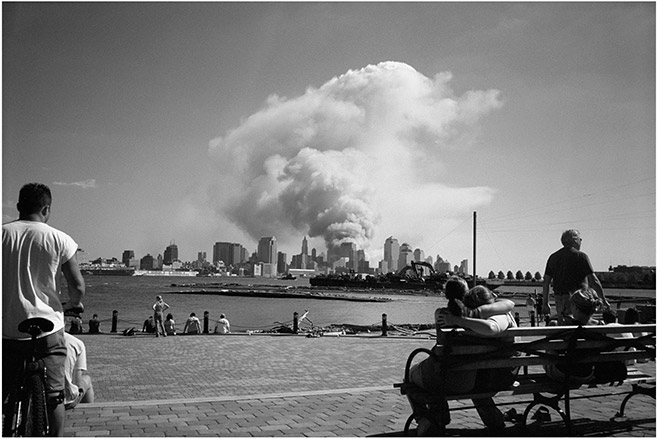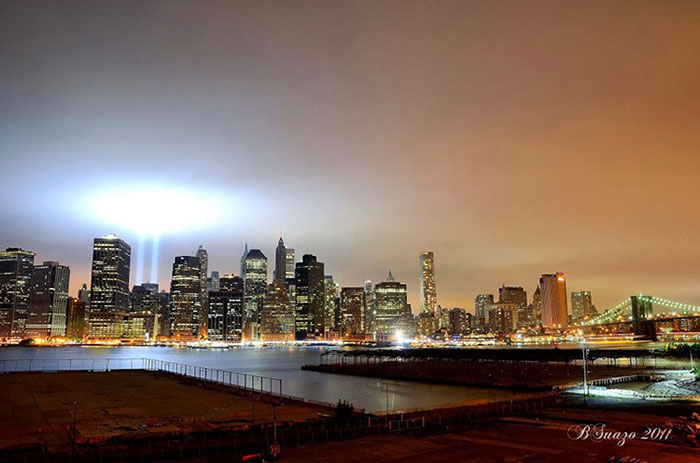About 9/11
A Look Back at the World Trade Center Tragedy
The History of the Center and First Terrorist Attack
Construction of the World Trade Center (WTC), a seven-building complex, began in 1966, revitalizing Lower Manhattan. Six years later, in 1973, the Twin Towers were built, establishing not only the centerpieces of the complex, but what became known as the symbol of America’s economic prosperity and its commitment to globalism. Designed by Architect Minoru Yamasaki and funded by the Port Authority of New York and New Jersey, the towers, also known as the North and South Towers, stood at 110 stories each, making them the tallest buildings in New York City and at one point the tallest in the world. Well known as a celebrated tourist site, the WTC was a popular venue for stunts. For example, in 1974, aerialist Philippe Petit walked on a high wire across both buildings. This popularity resulted in the World Observation Deck opening in 1976, followed by the opening of the restaurant Windows on the World, on the 106th and 107th floors of the North Tower.
Unfortunately, the popularity and symbolism of the towers made them targets of terrorist attacks. The first terrorist attack occurred on February 26, 1993, when a van carrying about 1,200 pounds of explosives detonated in the parking garage of the second-floor basement of the North Tower. The explosion killed six people and injured more than 1,000 people. The second attack occurred eight years later in late 2001.
The 9/11 Attack
On September 11, 2001, nineteen members of the Islamic extremist group al Qaeda hijacked four commercial airplanes, crashing them into the Twin Towers, the Pentagon, and a field in Pennsylvania. American Airlines Flight 11 took off from Boston at 7:59 a.m. Just a few minutes later, United Airlines Flight 175 also departed from Boston. At 8:45 a.m., Flight 11 crashed into the North Tower between the 93rd and 99th floors. Eighteen minutes later, United Airlines Flight 175 hit the South Tower between the 77th and 85th floors. Immense structural damage caused the South Tower to collapse at 9:59 a.m. The North Tower collapsed at 10:28 a.m. In the midst of all this, American Airlines Flight 77 took off from Dulles International Airport in Washington, D.C., and at 9:37 a.m., was flown into the Pentagon. The last plane, United Airlines Flight 93, took off from Newark International Airport and crashed into a field in Shanksville, Pennsylvania, at 10:10 a.m. after passengers on board attempted to gain control of the plane. At 5:21 p.m., several hours after the Twin Towers collapsed, 7 World Trade Center, a 47-story building, toppled due to the impact of debris from the collapse of the North Tower. Fortunately, the building had previously been evacuated, and there were no additional casualties.

Ryan Bonilla, 2001. Live Free or Die.
The Search and Rescue Mission Begins
As soon as the first plane hit, brave first responders, including the NYPD, FDNY, EMS, and Port Authority police, rushed to the WTC to evacuate 16,000 to 18,000 people who were in the complex. When the towers fell, their mission was to save those who were trapped or injured. Additionally, hundreds of vessels answered a call from the U.S. Coast Guard and the NYPD’s Harbor Unit to help aid in the evacuation efforts in New York Harbor. Through the coordination of the Coast Guard, upwards of 500,000 people were ferried from Battery Park/Lower Manhattan to safety. Additionally, thousands of people from Lower Manhattan walked over bridges and other routes to escape the downtown area, as vehicular traffic was restricted, subway service suspended, and tunnels closed.
During the search and rescue, the WTC became known as Ground Zero. For days, weeks, and months following the attacks, thousands of first responders, professionals from around the country, and New Yorkers from various trades volunteered at Ground Zero to help with the rescue, recovery, and clean-up efforts. Approximately 3,000 of those workers/volunteers were undocumented, many of whom were tasked with removing debris. Maritime vessels helped deliver supplies to support this effort. Debris from Ground Zero was transported to Arthur Kill Landfill on Staten Island for further shifting, recovery, and forensic analysis, under the auspicious of the Federal Bureau of Investigation and the NYPD. On May 30, 2002, the last piece of WTC steel was ceremonially removed. However, the Office of the New York City Medical Examiner continues to work to identify remains to bring closure to families by using advancements in DNA extraction techniques.
The Casualties
A total of 2,996 people died in the 9/11 attacks, including foreign nationals from more than 90 countries. An estimated 2,606 people in the World Trade Center and on the ground were killed because of the collapse of the Twin Towers. This figure includes more than 2,000 civilians, including eight EMTs and paramedics from private hospital units, and 412 emergency workers who responded to the WTC—343 firefighters and 23 New York City Police Officers. The casualties also reflect approximately 600 undocumented workers. Additionally, thousands of first responders and civilians who worked, lived, or went to school near the WTC have become ill or died in subsequent years due to exposure to toxic fumes and dust from fires ignited by the jet fuel. The fires burned for 99 days during the rescue and recovery operations.
The Federal Government Responds
Following the attacks, President George W. Bush pushed for a military response. On October 7, 2001, the United States began Operation Enduring Freedom, an international effort to protect the U.S. and other countries from Osama bin Laden’s terrorist organization. To combat further terrorism threats and encourage greater cooperation among government agencies, the Department of Homeland Security was established on November 25, 2002. Two days later, the National Commission on Terrorist Attacks was created. This Commission was responsible for “investigating the events that led up to September 11th.” The Commission’s report provides a comprehensive account of the events surrounding the 9/11 attacks and includes systemic recommendations designed to prevent future incidents. After September 11, there were concerns over nationalism, security and public safety, and the need to balance our freedoms and civil rights. Muslim and immigrant communities in America faced increased Islamophobia manifesting in everyday experiences of discrimination, anti-Muslim rhetoric, and safety issues.
In an effort to bring relief and support to eligible survivors and their families, Congress established the Victim Compensation Fund. Between 2001 and 2004, monetary compensation was given to the families of 9/11 victims and those most devastated by the events. Funding was renewed, and eligibility was expanded by President Barack Obama in 2011 when he signed the James Zadroga 9/11 Health and Compensation Act into law. The Zadroga Act, named after the late NYPD Detective James Zadroga, provides lifetime healthcare for first responders suffering illnesses after having been exposed to the toxic air. The law establishes the World Trade Center Health Program (WTCHP), providing no-cost medical monitoring and treatment for certified WTC-related health conditions to those directly affected by the 9/11 attacks. The Act also reauthorized the 9/11 Victim Compensation Fund (VCF) for five years, emphasizing those who were suffering debilitating physical conditions—it was closed in 2004 due to lack of funding. Again, in 2015, the Zadroga Act was reauthorized, with additional funding, and the claim period was extended.
In 2019 after significant advocacy by first responders, family members, New York lawmakers and other stakeholders, President Donald Trump signed a law authorizing continuing support for the September 11 Victim Compensation Fund through 2092. Essentially, The Never Forget the Heroes: James Zadroga, Ray Pfeifer, and Luis Alvarez Permanent Authorization of the September 11th Victim Compensation Fund is a long-lasting recognition of the impact of 9/11, as it authorizes the necessary appropriations to cover all eligible claims for this generation.
While the attacks killed and injured thousands, leaving a devastated nation and New York City in its wake, it also fostered a degree of unity and generosity. Multiple philanthropic funds, scholarships, and charities were established to support survivors and communities financially, in light of the many displaced workers, and to address unmet needs, including pro bono legal assistance. Further, victim service providers and counselors from across the country aided survivors through new and existing programs.
The Victims’ Legacy Lives On
To honor the victims, survivors, and their families, the 9/11 Memorial opened on the 10th anniversary of the attacks, on September 11, 2011. Designed by Michael Arad, the memorial features twin waterfall pools—one located where each of the towers once stood—surrounded by bronze panels inscribed with the names of all 2,983 victims, including those from the 1993 bombing, the Pentagon, and Shanksville crash. The 9/11 Memorial Museum opened to the public on May 21, 2014. In tribute to those who died or developed chronic illnesses resulting from toxic fumes exposure in the aftermath, the 9/11 Memorial Glade was dedicated on May 30, 2019. Additionally, each year in commemoration of 9/11, the twin beams of the Tribute in Light installation shine, honoring the victims and recalling the towers. In another tribute, the Freedom Tower—also known as the One World Trade Center—was built and opened on November 3, 2014. It stands at 1,776 feet tall and is the tallest building in the United States. Construction continues at the site, which will feature a Performing Arts Center to celebrate life and humanity.
As we mark the another anniversary of 9/11, we continue to honor the lives lost; pay tribute to the humanity, courage, and resilience in the aftermath; and reaffirm our commitment to justice and each other.

Brian Suazo, 2011. John Jay Photography Club
WTC Timeline
-
Construction Begins
-
The World Trade Center opens
-
1993 bombing
-
The World Trade Center is destroyed in the 9/11 terrorist attacks8:45 a.m.: Airplane crashes into the North Tower
9:02 a.m.: Flight 175 crashes into South Tower
9:59 a.m.: South Tower collapses
10:28 a.m.: North Tower collapses -
The FDNY extinguishes the fires at the World Trade Center after 99 days of burning
-
The first Tribute in Light memorial is revealed
-
The cleanup operation at the World Trade Center officially ends
-
Construction of the One World Trade Center begins
-
7 World Trade Center opens
-
Pope Benedict XVI visits the World Trade Center and blesses the site
-
Queen Elizabeth II places a wreath on the World Trade Center site
-
Tenth Anniversary
-
The 9/11 Memorial opens
-
4 World Trade Center officially opens
-
9/11 Memorial Museum officially opens
-
One World Trade Center opens
-
One World Observatory opens
-
Pope Francis prays at the Memorial South Pool and blesses the families of the victims of 9/11
-
The Oculus grand opening
-
20th Anniversary
